Seeds and Seedlings in a Changing World: A Systematic Review and Meta-Analysis from High Altitude and High Latitude Ecosystems
Abstract
1. Introduction
2. Materials and Methods
2.1. Literature Search and Selection Criteria
2.2. Characterization of Studies
2.3. Effects of Climate Change on the Early Life-History Stages of High Altitude and High Latitude Plants
2.3.1. Qualitative Analysis
2.3.2. Meta-Analysis
2.3.3. Study Heterogeneity and Publication Bias
3. Results
3.1. Literature Search
3.2. Characterization of Studies
3.2.1. Publication Metrics
3.2.2. Geographic Distribution
3.2.3. Ecosystems, Plant Communities and Species
3.2.4. Climate Change Scenarios and Early Life-History Stages
3.2.5. Methods and Experimental Conditions
3.3. Effects of Climate Change on the Early Life-History Stages of High Altitude and High Latitude Plants
3.3.1. Warming Temperature
3.3.2. Changes in Snow Cover
3.3.3. Changes in Precipitation
3.3.4. Nutrient Availability
3.3.5. Post-Fire Conditions
3.3.6. Heterogeneity and Publication Bias
4. Discussion
4.1. Effects of Climate Change on the Early Life-History Stages of High Altitude and High Latitude Plants
4.1.1. Warming Temperature
4.1.2. Changes in Snow Cover
4.1.3. Changes in Precipitation
4.1.4. Nutrient Availability
4.2. Heterogeneity and Publication Bias
4.3. Implications for Future Research
5. Conclusions
Supplementary Materials
Author Contributions
Funding
Data Availability Statement
Acknowledgments
Conflicts of Interest
References
- IPCC. Global Warming of 1.5 °C. An IPCC Special Report on the Impacts of Global Warming of 1.5 °C Above Pre-Industrial Levels and Related Global Greenhouse Gas Emission Pathways. In The Context of Strengthening the Global Response to the Threat of Climate Change; Masson-Delmotte, V., Zhai, P., Pörtner, H.-O., Roberts, D., Skea, J., Shukla, P.R., Pirani, A., Moufouma-Okia, W., Péan, C., Pidcock, R., et al., Eds.; Intergovernmental Panel on Climate Change: Genova, Switzerland, 2018. [Google Scholar]
- IPBES. Summary for Policymakers of the Global Assessment Report on Biodiversity and Ecosystem Services of the Intergovernmental Science-Policy Platform on Biodiversity and Ecosystem Services; Díaz, S., Settele, J., Brondízio, E.S., Ngo, H.T., Guèze, M., Agard, J., Arneth, A., Balvanera, P., Brauman, K.A., Butchart, S.H.M., et al., Eds.; IPBES Secretariat: Bonn, Germany, 2019; ISBN 978-3-947851-13-3. [Google Scholar]
- Stuart Chapin, F.; Körner, C. Arctic and Alpine Biodiversity: Patterns, Causes and Ecosystem Consequences. Trends Ecol. Evol. 1994, 9, 45–47. [Google Scholar] [CrossRef]
- Niskanen, A.K.J.; Niittynen, P.; Aalto, J.; Väre, H.; Luoto, M. Lost at High Latitudes: Arctic and Endemic Plants Under Threat as Climate Warms. Divers. Distrib. 2019, 25, 809–821. [Google Scholar] [CrossRef]
- Gottfried, M.; Pauli, H.; Futschik, A.; Akhalkatsi, M.; Barančok, P.; Benito Alonso, J.L.; Coldea, G.; Dick, J.; Erschbamer, B.; Fernández Calzado, M.R.; et al. Continent-Wide Response of Mountain Vegetation to Climate Change. Nat. Clim. Chang. 2012, 2, 111–115. [Google Scholar] [CrossRef]
- Guisan, A.; Theurillat, J.-P. Assessing Alpine Plant Vulnerability to Climate Change: A Modeling Perspective. Integr. Assess. 2000, 1, 307–320. [Google Scholar] [CrossRef]
- Hock, R.; Rasul, G.; Adler, C.; Cáceres, B.; Gruber, S.; Hirabayashi, Y.; Jackson, M.; Kääb, A.; Kang, S.; Kutuzov, S.; et al. High Mountain Areas; Pörtner, H.-O., Roberts, D.C., Masson-Delmotte, V., Zhai, P., Tignor, M., Poloczanska, E., Mintenbeck, K., Alegría, A., Nicolai, M., Okem, A., et al., Eds.; Intergovernmental Panel on Climate Change: Geneva, Switzerland, 2019. [Google Scholar]
- Sánchez-Bayo, F.; Green, K. Australian Snowpack Disappearing Under the Influence of Global Warming and Solar Activity. Arct. Antarct. Alp. Res. 2013, 45, 107–118. [Google Scholar] [CrossRef]
- Palazzi, E.; Von Hardenberg, J.; Provenzale, A. Precipitation in the Hindu-Kush Karakoram Himalaya: Observations and Future Scenarios. J. Geophys. Res. Atmos. 2013, 118, 85–100. [Google Scholar] [CrossRef]
- Paul, F.; Kääb, A.; Maisch, M.; Kellenberger, T.; Haeberli, W. Rapid Disintegration of Alpine Glaciers Observed with satellite data. Geophys. Res. Lett. 2004, 31, 10–15. [Google Scholar] [CrossRef]
- Zemp, M.; Frey, H.; Gärtner-Roer, I.; Nussbaumer, S.U.; Hoelzle, M.; Paul, F.; Haeberli, W.; Denzinger, F.; Ahlstrøm, A.P.; Anderson, B.; et al. Historically Unprecedented Global Glacier Decline in the Early 21st century. J. Glaciol. 2015, 61, 745–762. [Google Scholar] [CrossRef]
- Vanneste, T.; Michelsen, O.; Graae, B.J.; Kyrkjeeide, M.O.; Holien, H.; Hassel, K.; Lindmo, S.; Kapás, R.E.; De Frenne, P. Impact of Climate Change on Alpine Vegetation of Mountain Summits in Norway. Ecol. Res. 2017, 32, 579–593. [Google Scholar] [CrossRef]
- Hedhly, A.; Hormaza, J.I.; Herrero, M. Global Warming and Sexual Plant Reproduction. Trends Plant Sci. 2009, 14, 30–36. [Google Scholar] [CrossRef] [PubMed]
- Walck, J.L.; Hidayati, S.N.; Dixon, K.W.; Thompson, K.; Poschlod, P. Climate Change and Plant Regeneration from Seed. Glob. Chang. Biol. 2011, 17, 2145–2161. [Google Scholar] [CrossRef]
- Cochrane, A.; Daws, M.I.; Hay, F.R. Seed-Based Approach for Identifying Flora at Risk from Climate Warming. Austral. Ecol. 2011, 36, 923–935. [Google Scholar] [CrossRef]
- Cochrane, A. Can sensitivity to Temperature during Germination Help Predict Global Warming Vulnerability? Seed Sci. Res. 2016, 26, 14–29. [Google Scholar] [CrossRef]
- Körner, C. Alpine Plant Life; Springer: Basel, Switzerland, 2013. [Google Scholar]
- Venn, S.E.; Morgan, J.W. Germination characteristics of Mountain Celery. Vic. Nat. 2009, 126, 4–12. [Google Scholar]
- Xu, J.; Li, W.; Zhang, C.; Liu, W.; Du, G. The Determinants of Seed Germination in an Alpine/Subalpine Community on the Eastern Qinghai-Tibetan Plateau. Ecol. Eng. 2017, 98, 114–122. [Google Scholar] [CrossRef]
- Fernández-Pascual, E.; Carta, A.; Mondoni, A.; Cavieres, L.A.; Rosbakh, S.; Venn, S.; Satyanti, A.; Guja, L.; Briceño, V.F.; Vandelook, F.; et al. The Seed Germination Spectrum of Alpine Plants: A Global Meta-Analysis. New Phytol. 2020. [Google Scholar] [CrossRef]
- Mondoni, A.; Rossi, G.; Orsenigo, S.; Probert, R.J. Climate Warming Could Shift the Timing of Seed Germination in Alpine Plants. Ann. Bot. 2012, 110, 155–164. [Google Scholar] [CrossRef]
- Milbau, A.; Graae, B.J.; Shevtsova, A.; Nijs, I. Effects of a Warmer Climate on Seed Germination in the Subarctic. Ann. Bot. 2009, 104, 287–296. [Google Scholar] [CrossRef]
- Briceño, V.F.; Hoyle, G.L.; Nicotra, A.B. Seeds at risk: How will a Changing Alpine Climate Affect Regeneration from Seeds in Alpine Areas? Alp. Bot. 2015, 125, 59–68. [Google Scholar] [CrossRef]
- Billings, W.D.; Mooney, H.A. The Ecology of Artic and Alpine Plants. Biol. Rev. 1968, 43, 481–529. [Google Scholar] [CrossRef]
- Venn, S.E.; Morgan, J.W. Soil Seedbank Composition and Dynamics across Alpine Summits in South-Eastern Australia. Aust. J. Bot. 2010, 58, 349–362. [Google Scholar] [CrossRef]
- Hoyle, G.L.; Venn, S.E.; Steadman, K.J.; Good, R.B.; Mcauliffe, E.J.; Williams, E.R.; Nicotra, A.B. Soil Warming Increases Plant Species Richness but Decreases Germination from the Alpine Soil Seed Bank. Glob. Chang. Biol. 2013, 19, 1549–1561. [Google Scholar] [CrossRef] [PubMed]
- Forbis, T.A. Seedling Demography in an Alpine Ecosystem. Am. J. Bot. 2003, 90, 1197–1206. [Google Scholar] [CrossRef]
- Venn, S.E.; Morgan, J.W. Patterns in Alpine Seedling Emergence and Establishment Across a Stress Gradient of Mountain Summits in South-Eastern Australia. Plant Ecol. Divers. 2009, 2, 5–16. [Google Scholar] [CrossRef]
- Pluess, A.R.; Stöcklin, J. Population Genetic Diversity of the Clonal Plant Geum Reptans (Rosaceae) in the Swiss Alps. Am. J. Bot. 2004, 91, 2013–2021. [Google Scholar] [CrossRef] [PubMed]
- Jonsson, B.O.; Jonsdottir, I.S.; Cronberg, N. Clonal Diversity and Allozyme Variation in Populations of the Arctic Sedge Carex Bigelowii (Cyperaceae). J. Ecol. 1996, 84, 449. [Google Scholar] [CrossRef]
- Arft, A.M.; Walker, M.D.; Gurevitch, J.; Alatalo, J.M.; Bret-Harte, M.S.; Dale, M.; Diemer, M.; Gugerli, F.; Henry, G.H.R.; Jones, M.H.; et al. Responses of Tundra Plants to Experimental Warming: Meta-Analysis of the International Tundra Experiment. Ecol. Monogr. 1999, 69, 491–511. [Google Scholar] [CrossRef]
- Jaganathan, G.K.; Dalrymple, S.E. Inconclusive Predictions and Contradictions: A Lack of Consensus on Seed Germination Response to Climate Change at High Altitude and High Latitude. J. Bot. 2016. [Google Scholar] [CrossRef]
- Lett, S.; Dorrepaal, E. Global Drivers of Tree Seedling Establishment at Alpine Treelines in a Changing Climate. Funct. Ecol. 2018, 32, 1666–1680. [Google Scholar] [CrossRef]
- Pickering, C.; Byrne, J. The benefits of Publishing Systematic Quantitative Literature Reviews for PhD Candidates and other Early-Career Researchers. High. Educ. Res. Dev. 2014, 33, 534–548. [Google Scholar] [CrossRef]
- Liberati, A.; Altman, D.G.; Tetzlaff, J.; Mulrow, C.; Gøtzsche, P.C.; Ioannidis, J.P.A.; Clarke, M.; Devereaux, P.J.; Kleijnen, J.; Moher, D. The PRISMA statement for Reporting Systematic Reviews and Meta-Analyses of Studies that Evaluate Healthcare Interventions: Explanation and Elaboration. BMJ 2009, 339. [Google Scholar] [CrossRef]
- van Eck, N.J.; Waltman, L. Software Survey: VOSviewer, a Computer Program for Bibliometric Mapping. Scientometrics 2010, 84, 523–538. [Google Scholar] [CrossRef] [PubMed]
- Schindelin, J.; Arganda-Carreras, I.; Frise, E.; Kaynig, V.; Longair, M.; Pietzsch, T.; Preibisch, S.; Rueden, C.; Saalfeld, S.; Schmid, B.; et al. Fiji: An Open-Source Platform for Biological-Image Analysis. Nat. Methods 2012, 9, 676–682. [Google Scholar] [CrossRef]
- Hillebrand, H.; Gurevitch, J. Meta-Analysis Results are Unlikely to be biased by Differences in Variance and Replication between Ecological Lab and Field Studies. Oikos 2014, 123, 794–799. [Google Scholar] [CrossRef]
- Koricheva, J.; Gurevitch, J. Uses and Misuses of Meta-Analysis in Plant Ecology. J. Ecol. 2014, 102, 828–844. [Google Scholar] [CrossRef]
- Giménez-Benavides, L.; Escudero, A.; García-Camacho, R.; García-Fernández, A.; Iriondo, J.M.; Lara-Romero, C.; Morente-López, J. How does Climate Change Affect Regeneration of Mediterranean High-Mountain Plants? An Integration and Synthesis of Current Knowledge. Plant Biol. 2018, 20, 50–62. [Google Scholar] [CrossRef] [PubMed]
- Shevtsova, A.; Graae, B.J.; Jochum, T.; Milbau, A.; Kockelbergh, F.; Beyens, L.; Nijs, I. Critical Periods for Impact of Climate Warming on Early Seedling Establishment in Subarctic Tundra. Glob. Chang. Biol. 2009, 15, 2662–2680. [Google Scholar] [CrossRef]
- Graae, B.J.; Alsos, I.G.; Ejrnaes, R. The Impact of Temperature Regimes on Development, Dormancy Breaking and Germination of Dwarf Shrub Seeds from Arctic, Alpine and Boreal Sites. Plant Ecol. 2008, 198, 275–284. [Google Scholar] [CrossRef]
- Wookey, P.A.; Robinson, C.H.; Parsons, A.N.; Welker, J.M.; Press, M.C.; Callaghan, T.V.; Lee, J.A. Environmental Constraints on the Growth, Photosynthesis and Reproductive Development of Dryas Octopetala at a High Arctic polar Semi-Desert, Svalbard. Oecologia 1995, 102, 478–489. [Google Scholar] [CrossRef]
- Verrall, B.; Pickering, C.M. Alpine Vegetation in the Context of Climate Change: A Global Review of Past Research and Future Directions. Sci. Total Environ. 2020, 748, 141344. [Google Scholar] [CrossRef]
- Kennedy, A.D. Temperature Effects of Passive Greenhouse Apparatus in High-Latitude Climate Change Experiments. Funct. Ecol. 1995, 9, 340. [Google Scholar] [CrossRef]
- Kennedy, A.D. Simulated Climate Change: Are Passive Greenhouses a Valid Microcosm for Testing the Biological Effects of Environmental Perturbations? Glob. Chang. Biol. 1995, 1, 29–42. [Google Scholar] [CrossRef]
- Kreyling, J.; Beier, C. Complexity in Climate Change Manipulation Experiments. Bioscience 2013, 63, 763–767. [Google Scholar] [CrossRef]
- Korell, L.; Auge, H.; Chase, J.M.; Harpole, S.; Knight, T.M. We Need More Realistic Climate Change Experiments for Understanding Ecosystems of the Future. Glob. Chang. Biol. 2019, 1–3. [Google Scholar] [CrossRef] [PubMed]
- Milbau, A.; Vandeplas, N.; Kockelbergh, F.; Nijs, I. Both Seed Germination and Seedling Mortality Increase with Experimental Warming and Fertilization in a Subarctic Tundra. AoB Plants 2017, 9, 1–13. [Google Scholar] [CrossRef] [PubMed]
- Loranger, H.; Zotz, G.; Bader, M.Y. Early Establishment of trees at the Alpine Treeline: Idiosyncratic Species Responses to Temperature-Moisture Interactions. AoB Plants 2016, 8. [Google Scholar] [CrossRef]
- Wang, G.; Baskin, C.C.; Baskin, J.M.; Yang, X.; Liu, G.; Ye, X.; Zhang, X.; Huang, Z. Effects of Climate Warming and Prolonged Snow Cover on Phenology of the Early Life History Stages of Four Alpine Herbs on the Southeastern Tibetan Plateau. Am. J. Bot. 2018, 105, 967–976. [Google Scholar] [CrossRef] [PubMed]
- Hansen, W.D.; Turner, M.G. Origins of Abrupt Change? Postfire Subalpine Conifer Regeneration Declines Nonlinearly with Warming and Drying. Ecol. Monogr. 2019, 89, e01340. [Google Scholar] [CrossRef]
- Meineri, E.; Spindelböck, J.; Vandvik, V. Seedling Emergence Responds to Both Seed Source and Recruitment Site Climates: A Climate Change Experiment Combining Transplant and Gradient Approaches. Plant Ecol. 2013, 214, 607–619. [Google Scholar] [CrossRef]
- Graae, B.J.; Ejrnæs, R.; Marchand, F.L.; Milbau, A.; Shevtsova, A.; Beyens, L.; Nijs, I. The Effect of an Early-Season Short-Term Heat Pulse on Plant Recruitment in the Arctic. Polar Biol. 2009, 32, 1117–1126. [Google Scholar] [CrossRef]
- Munier, A.; Hermanutz, L.; Jacobs, J.D.; Lewis, K. The Interacting Effects of Temperature, Ground Disturbance, and Herbivory on Seedling Establishment: Implications for Treeline Advance with Climate Warming. Plant Ecol. 2010, 210, 19–30. [Google Scholar] [CrossRef]
- Kueppers, L.M.; Faist, A.; Ferrenberg, S.; Castanha, C.; Conlisk, E.; Wolf, J. Lab and Field Warming Similarly Advance Germination Date and Limit Germination Rate for High and Low Elevation Provenances of Two Widespread Subalpine Conifers. Forests 2017, 8, 433. [Google Scholar] [CrossRef]
- Mondoni, A.; Pedrini, S.; Bernareggi, G.; Rossi, G.; Abeli, T.; Probert, R.J.; Ghitti, M.; Bonomi, C.; Orsenigo, S. Climate Warming Could Increase Recruitment Success in Glacier Foreland Plants. Ann. Bot. 2015, 116, 907–916. [Google Scholar] [CrossRef] [PubMed]
- Walder, T.; Erschbamer, B. Temperature and Drought Drive Differences in Germination Responses Between Congeneric Species Along Altitudinal Gradients. Plant Ecol. 2015, 216, 1297–1309. [Google Scholar] [CrossRef]
- Piper, F.I.; Fajardo, A.; Cavieres, L.A. Simulated Warming does not Impair Seedling Survival and Growth of Nothofagus Pumilio in the Southern Andes. Perspect. Plant Ecol. Evol. Syst. 2013, 15, 97–105. [Google Scholar] [CrossRef]
- Tingstad, L.; Olsen, S.L.; Klanderud, K.; Vandvik, V.; Ohlson, M. Temperature, Precipitation and Biotic Interactions as Determinants of Tree Seedling Recruitment across the Tree Line Ecotone. Oecologia 2015, 179, 599–608. [Google Scholar] [CrossRef] [PubMed]
- Tercero-Bucardo, N.; Kitzberger, T.; Veblen, T.T.; Raffaele, E. A Field Experiment on Climatic and Herbivore Impacts on Post-Fire Tree Regeneration in North-Western Patagonia. J. Ecol. 2007, 95, 771–779. [Google Scholar] [CrossRef]
- Moyes, A.B.; Castanha, C.; Germino, M.J.; Kueppers, L.M. Warming and the Dependence of Limber Pine (Pinus Flexilis) Establishment on Summer Soil Moisture within and above its Current Elevation Range. Oecologia 2013, 171, 271–282. [Google Scholar] [CrossRef]
- Kueppers, L.M.; Conlisk, E.; Castanha, C.; Moyes, A.B.; Germino, M.J.; de Valpine, P.; Torn, M.S.; Mitton, J.B. Warming and Provenance Limit Tree Recruitment Across and Beyond the Elevation Range of Subalpine Forest. Glob. Chang. Biol. 2017, 23, 2383–2395. [Google Scholar] [CrossRef]
- Schmidt, I.K.; Jonasson, S.; Shaver, G.R.; Michelsen, A.; Nordin, A. Mineralization and Distribution of Nutrients in Plants and Microbes in Four Arctic Ecosystems: Responses to Warming. Plant Soil 2002, 242, 93–106. [Google Scholar] [CrossRef]
- Rustad, L.E.; Campbell, J.L.; Marion, G.M.; Norby, R.J.; Mitchell, M.J.; Hartley, A.E.; Cornelissen, J.H.C.; Gurevitch, J.; Alward, R.; Beier, C.; et al. A Meta-Analysis of the Response of Soil Respiration, Net Nitrogen Mineralization, and Aboveground Plant Growth to Experimental Ecosystem Warming. Oecologia 2001, 126, 543–562. [Google Scholar] [CrossRef] [PubMed]
- Langner, J.; Bergström, R.; Foltescu, V. Impact of Climate Change on Surface Ozone and Deposition of Sulphur and Nitrogen in Europe. Atmos. Environ. 2005, 39, 1129–1141. [Google Scholar] [CrossRef]
- Petraglia, A.; Carbognani, M.; Tomaselli, M. Effects of Nutrient Amendments on Modular Growth, Flowering Effort and Reproduction of Snowbed Plants. Plant Ecol. Divers. 2013, 6, 475–486. [Google Scholar] [CrossRef]
- Baskin, C.C.; Baskin, J.M. Seeds. Ecology, Biogeography, and Evolution of Dormancy and Germination, 2nd ed.; Academic Press: London, UK, 2014; ISBN 9780124166776. [Google Scholar]
- Nakagawa, S.; Noble, D.W.A.; Senior, A.M.; Lagisz, M. Meta-Evaluation of Meta-Analysis: Ten Appraisal Questions for Biologists. BMC Biol. 2017, 15, 18. [Google Scholar] [CrossRef] [PubMed]
- Sterne, J.A.C.; Sutton, A.J.; Ioannidis, J.P.A.; Terrin, N.; Jones, D.R.; Lau, J.; Carpenter, J.; Rücker, G.; Harbord, R.M.; Schmid, C.H.; et al. Recommendations for Examining and Interpreting Funnel Plot Asymmetry in Meta-Analyses of Randomised Controlled Trials. BMJ 2011, 343, 1–8. [Google Scholar] [CrossRef]
- Aerts, R.; Cornelissen, J.H.C.; Dorrepaal, E. Plant Performance in a Warmer World: General Responses of Plants from Cold, Northern Biomes and the Importance of Winter and Spring events. Plant Ecol. 2006, 182, 65–77. [Google Scholar] [CrossRef]
- Flannigan, M.D.; Krawchuk, M.A.; De Groot, W.J.; Wotton, B.M.; Gowman, L.M. Implications of Changing Climate for Global Wildland Fire. Int. J. Wildl. Fire 2009, 18, 483–507. [Google Scholar] [CrossRef]
- Qiu, J. Arctic ecology: Tundra’s burning. Nature 2009, 461, 34–36. [Google Scholar] [CrossRef][Green Version]
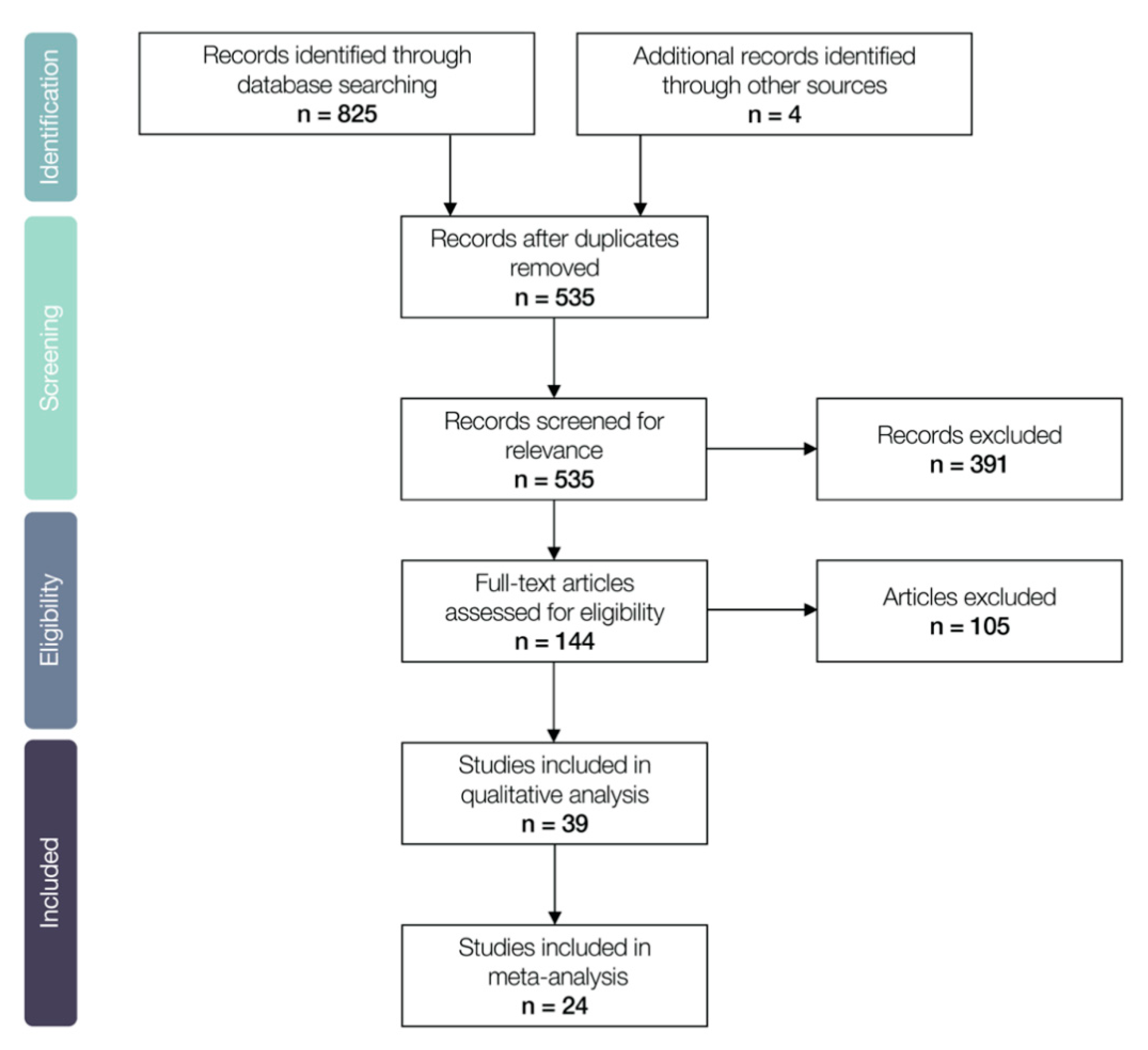
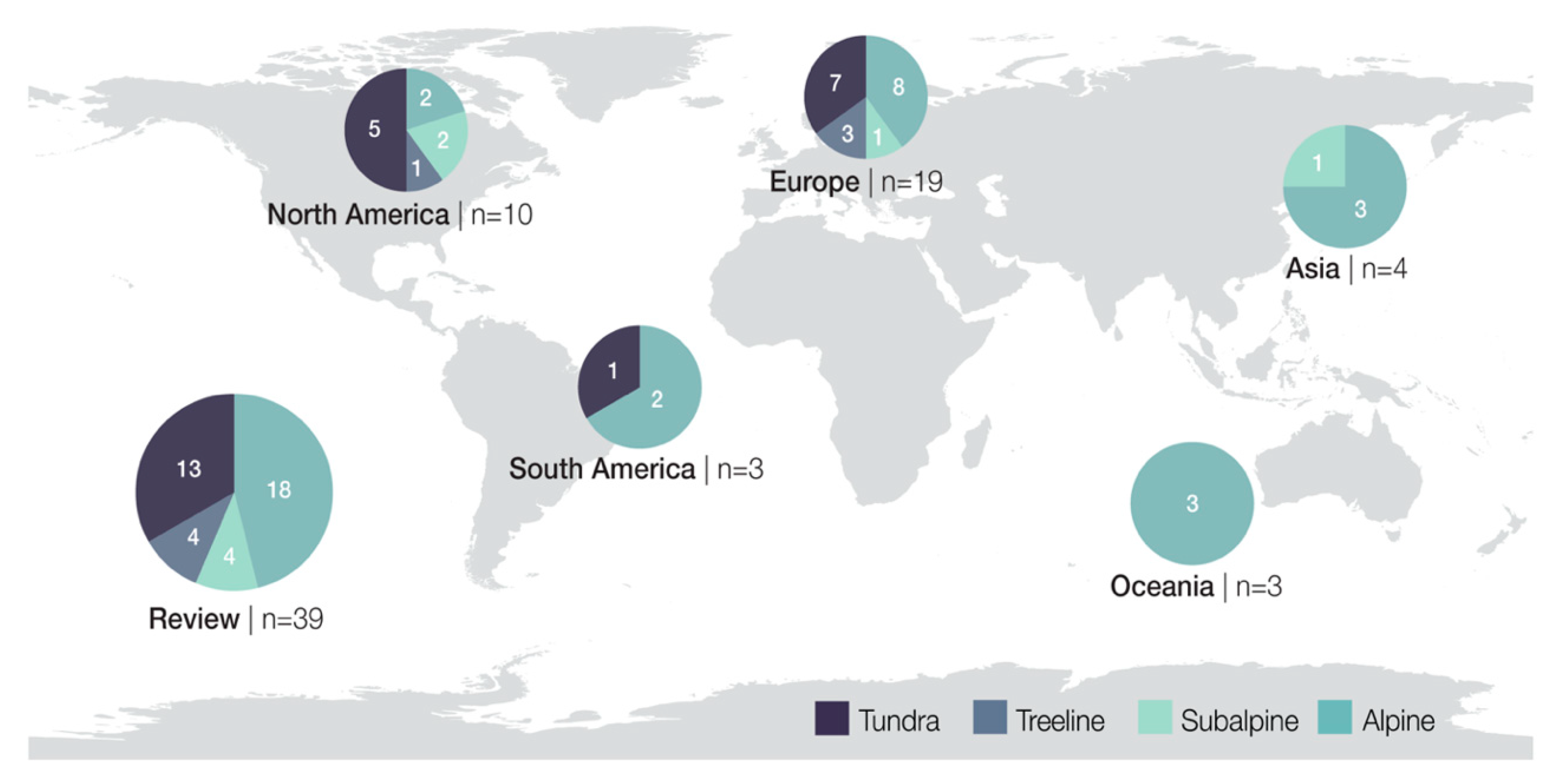
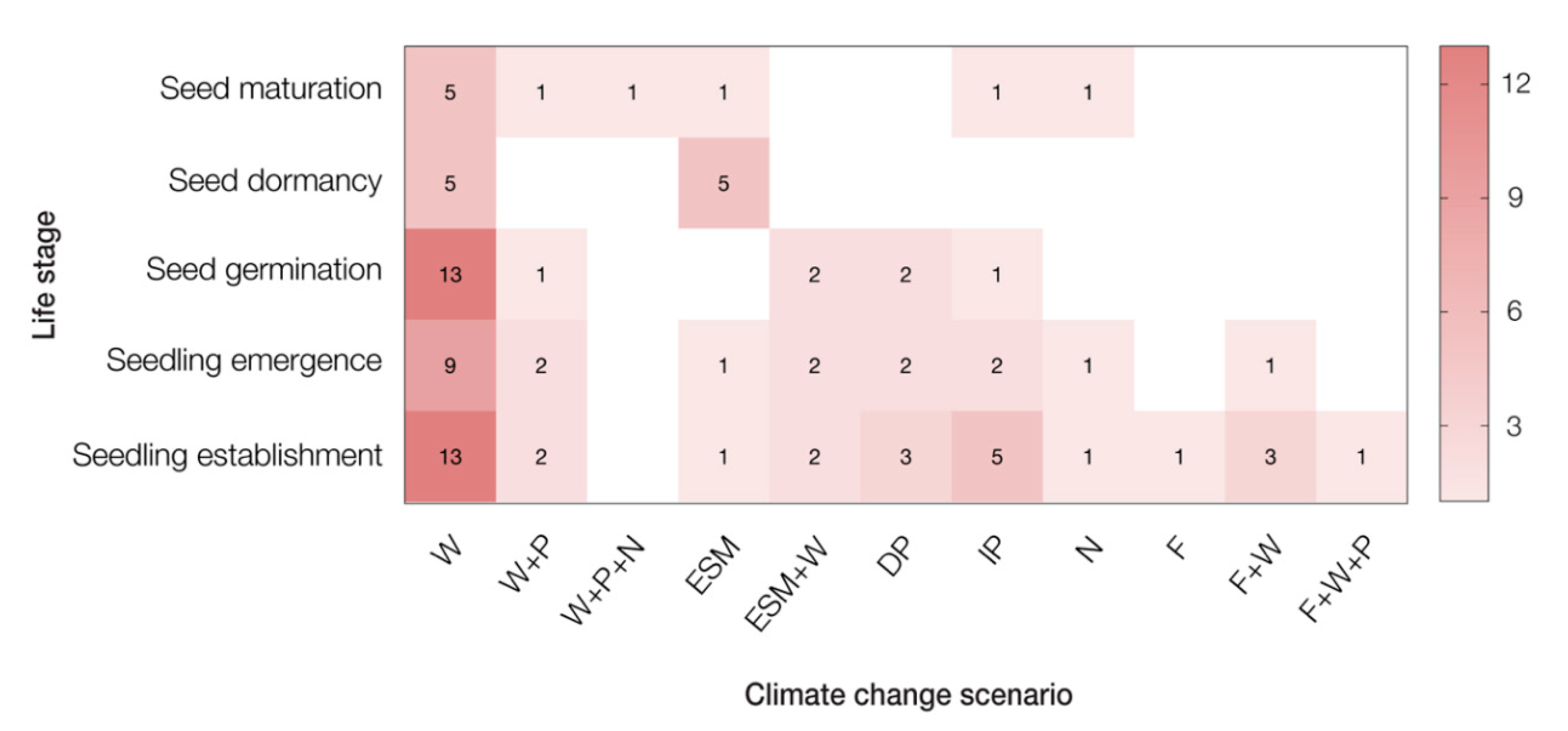
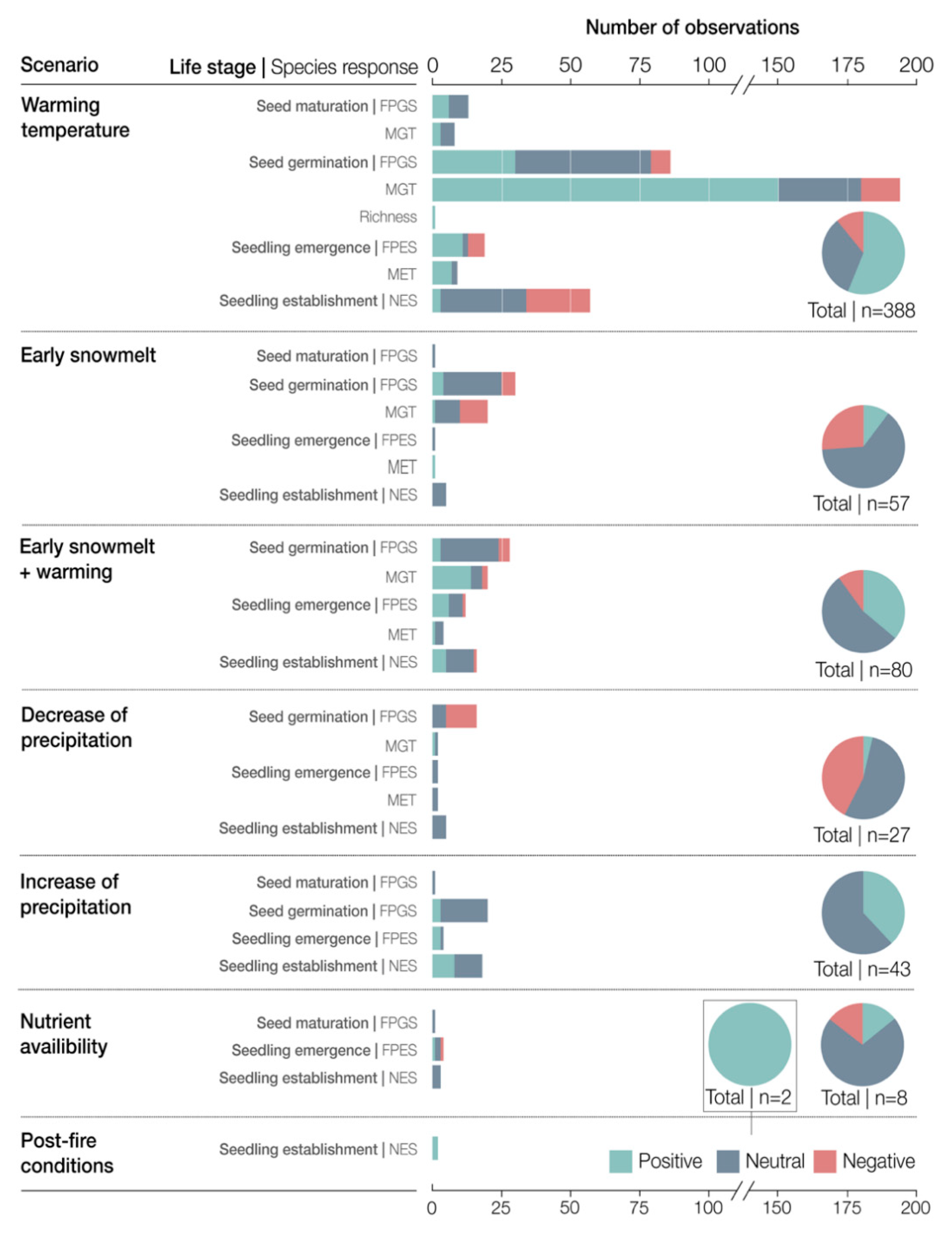
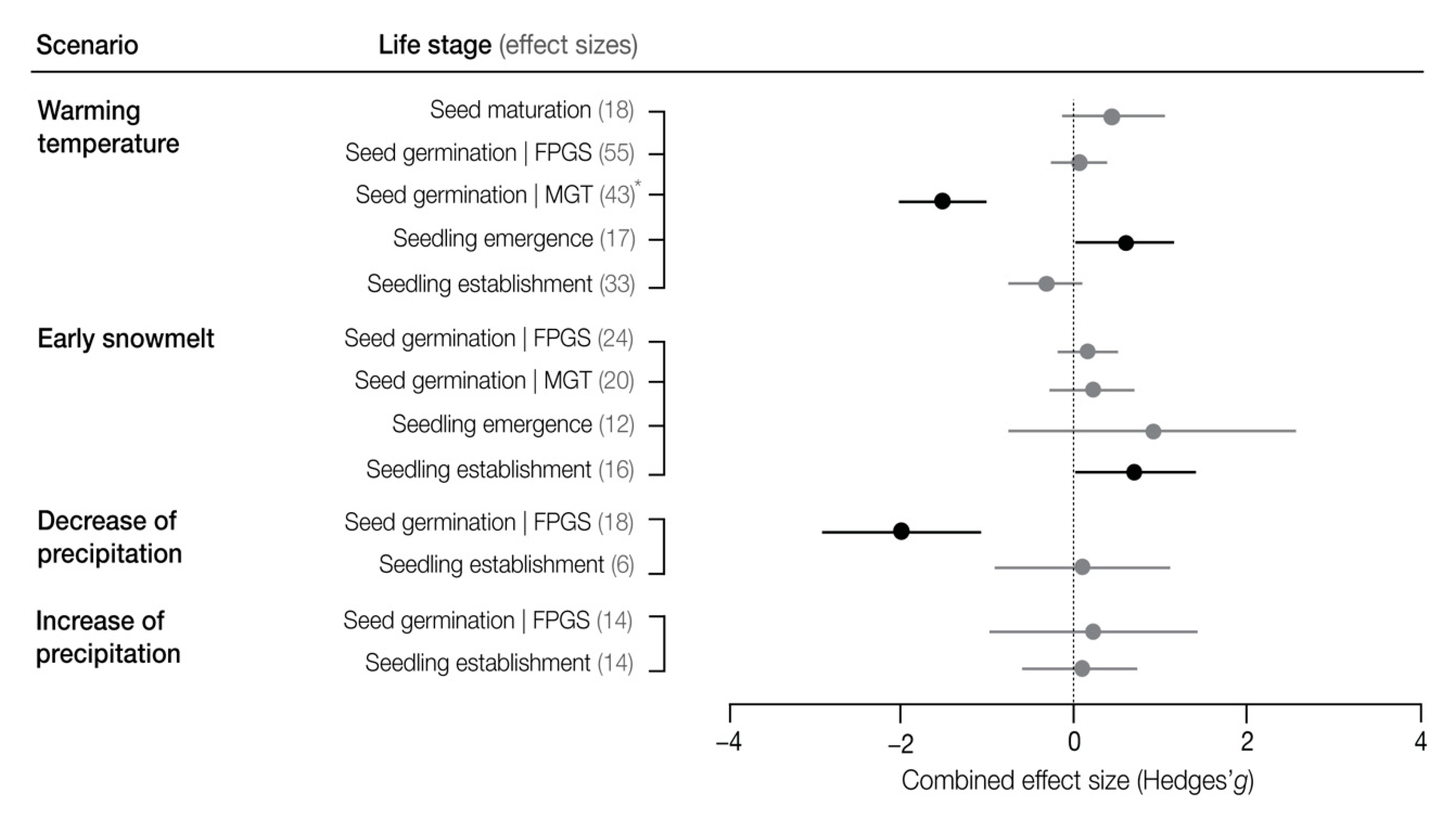
| Environmental Variable | Particularities of the Methods | Categories | No. of Instances |
|---|---|---|---|
| Temperature | Where was modified? | Laboratory/Glasshouse | 10 |
| Field | 18 | ||
| Combination of both | 7 | ||
| How was modified? | Growth chambers (laboratory) | 11 | |
| Temperature controlled glasshouse | 2 | ||
| Open-top chambers and similar | 11 | ||
| Infrared heaters and similar | 5 | ||
| In situ glasshouse | 3 | ||
| Natural gradient | 3 | ||
| How much was modified vs. control? | +1 °C | 7 | |
| +2 °C | 13 | ||
| +3 °C | 2 | ||
| +4 °C | 3 | ||
| +5 °C | 6 | ||
| More than +5 °C | 4 | ||
| Snow cover | Where was modified? | Laboratory | 4 |
| Field | 4 | ||
| Combination of both | 2 | ||
| How was modified? | Modifying temperature in growth chambers or similar (laboratory) | 6 | |
| Adding or removing snow | 6 | ||
| How much was modified vs. control? | −4 months (all winter) | 1 | |
| −10 weeks | 1 | ||
| −8 weeks | 3 | ||
| −4 weeks | 1 | ||
| −2 weeks | 1 | ||
| +1 weeks | 2 | ||
| +2 weeks | 1 | ||
| Water availability | Where was modified? | Laboratory | 2 |
| Field | 9 | ||
| Combination of both | 3 | ||
| How was modified? | Water potential solutions | 2 | |
| Restricting rain or adding water | 9 | ||
| Using a natural gradient | 3 | ||
| How much was modified vs. control? | +50% mean annual precipitation | 4 | |
| +35% mean annual precipitation | 1 | ||
| +20% mean annual precipitation | 2 | ||
| +10% mean annual precipitation | 2 | ||
| −20% mean annual precipitation | 1 | ||
| −50% mean annual precipitation | 2 | ||
| 1 to 0.5 PEG solution concentration | 2 | ||
| 0.5 to 0.1 PEG solution concentration | 2 | ||
| Nutrient availability | Where? | Field | 5 |
| How? | Adding nutrients | 5 | |
| How much? | 1 to 5 g/per m2 year | 2 | |
| 5 to 15 g/per m2 year | 2 | ||
| >15 g/per m2 year | 1 | ||
| Post-fire conditions | Where? | Field | 3 |
| How? | Natural post-fire conditions | 3 |
Publisher’s Note: MDPI stays neutral with regard to jurisdictional claims in published maps and institutional affiliations. |
© 2021 by the authors. Licensee MDPI, Basel, Switzerland. This article is an open access article distributed under the terms and conditions of the Creative Commons Attribution (CC BY) license (https://creativecommons.org/licenses/by/4.0/).
Share and Cite
Vázquez-Ramírez, J.; Venn, S.E. Seeds and Seedlings in a Changing World: A Systematic Review and Meta-Analysis from High Altitude and High Latitude Ecosystems. Plants 2021, 10, 768. https://doi.org/10.3390/plants10040768
Vázquez-Ramírez J, Venn SE. Seeds and Seedlings in a Changing World: A Systematic Review and Meta-Analysis from High Altitude and High Latitude Ecosystems. Plants. 2021; 10(4):768. https://doi.org/10.3390/plants10040768
Chicago/Turabian StyleVázquez-Ramírez, Jerónimo, and Susanna E. Venn. 2021. "Seeds and Seedlings in a Changing World: A Systematic Review and Meta-Analysis from High Altitude and High Latitude Ecosystems" Plants 10, no. 4: 768. https://doi.org/10.3390/plants10040768
APA StyleVázquez-Ramírez, J., & Venn, S. E. (2021). Seeds and Seedlings in a Changing World: A Systematic Review and Meta-Analysis from High Altitude and High Latitude Ecosystems. Plants, 10(4), 768. https://doi.org/10.3390/plants10040768






